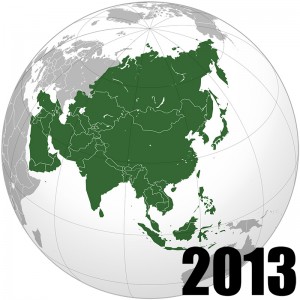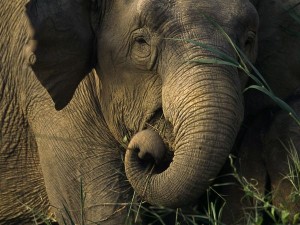 Asia Population 2013
Asia Population 2013
Asia is the world’s largest and most populous continent with a population of 4.3 billion people. Located primarily in the eastern and northern hemispheres, Asia covers 8.7% of the Earth’s total surface area and comprises 30% of its land area. With approximately 4.3 billion people, it makes up 60% of the world’s current human population. Asia’s growth rate is very high for the modern era and has quadrupled during the last 100 years. Asia’s wealth of natural resources, ecological variability, and biological diversity put it in a great position to support such a high growth rate. Asia’s population growth and quickly growing economic development efforts are threatening the region’s rich and limited resources through their expansion and intensification of agriculture, uncontrolled growth of industrialization, destruction of natural habitats, and urban sprawl.
Asian populations will continue to grow for many decades to come which will lead to increasing pressure on the region’s natural resources. Based on historical growth rates and national calculations, it is estimated that between 2000 and 2050 the national populations are expected to grow in every country of East, Southeast, and South and Central Asia except for Japan and Kazakhstan. Populations will double or nearly double in Pakistan, Nepal, Bangladesh, Afghanistan, Cambodia, and Laos. Growth rates will also be particularly high in India, Indonesia, Iran, Malaysia, Mongolia, Myanmar, the Philippines, and Vietnam. Much of the population growth projected for the next few decades will occur in countries that are least capable of coping with additional stress on land, water, and other natural resources. According to a recent studies, countries where population is projected to grow fastest have some of the lowest income levels in the world. These countries already rank high in terms of environmental stress.
Asia Borders
Asia’s borders define four-fifths of the eastern side of Eurasia. It is located to the east of the Suez Canal, the Ural River, and the Ural Mountains, and south of the Caucasus Mountains and the Caspian and Black Seas. It is bounded on the east by the Pacific Ocean, on the south by the Indian Ocean and on the north by the Arctic Ocean.
Asia Economy
Asia has the second largest nominal GDP of all continents, after Europe, but the largest when measured in purchasing power parity. As of 2011, the largest economies in Asia are China, Japan, India, South Korea and Indonesia. Based on Global Office Locations 2011, Asia dominated the office locations with 4 of top 5 were in Asia, Hong Kong, Singapore, Tokyo, Seoul and Shanghai. Around 68 percent of international firms have offices in Hong Kong.
Asia Air Pollution
Asian cities are among the most polluted in the world. Of the 15 largest cities on the planet with the worst air pollution 12 are in Asia. Suspended particulate levels in Delhi, Beijing, Karachi, and Jakarta are many times higher than recommended by the World Health Organization. In the countryside, nitrates from animal waste and chemical fertilizers pollute the soil and water, and in the cities, the air is contaminated with lead from vehicle exhaust. In India’s largest cities, Mumbai and Delhi, about one-half of children under age 3 show signs of harmful exposure to lead. Such elevated levels of lead in the blood can be harmful to the developing brain and central nervous system of young children and can cause damage to other body organs. In the poorest countries of Asia, indoor air pollution may pose an even greater hazard for human health. Cooking and heating with wood, crop residues, animal dung, and low-quality coal produce smoke that contains dangerous particles and gases. When fuels such as these are burned indoors, using inefficient stoves and poor ventilation, they can cause tuberculosis, other serious respiratory diseases, and blindness. In fact, indoor air pollution from cooking and heating with unsafe fuels has been designated by the World Bank as one of the four most critical environmental problems in developing countries.
 Asian Elephants
Asian Elephants
The Asian elephant is one of two species of elephants alive today. They vary greatly in size between the four subspecies, although all are smaller than the large African elephant. Throughout their range, Asian elephants experience an array of temperatures, although their habitats are found in tropical areas near the equator.
The Asian elephant can live in a wide variety of habitats, including jungle and mountain forests, but they tend to prefer forest edges bordered by grasslands and short woody plants. Due to conflicts with humans, these elephants have progressively moved into more remote areas where human interaction and conflict is at a minimum. The forested blocks can be moist, lowland evergreen forests to the much drier forests found at elevations up to 10,000 feet.
Top 10 Asian Countries by Population
| Rank | Country | Population |
| 1 | China | 1,357,379,000 |
| 2 | India | 1,257,476,000 |
| 3 | Indonesia | 248,731,000 |
| 4 | Pakistan | 183,936,000 |
| 5 | Bangladesh | 154,514,000 |
| 6 | Japan | 127,223,000 |
| 7 | Philippines | 98,007,000 |
| 8 | Vietnam | 89,702,000 |
| 9 | Iran | 76,789,000 |
| 10 | Turkey | 76,081,000 |
Animated Chart of Population Growth in Asia
Other Asia Resources
Learn more about Asia Population Statistics here.
To learn more about the Africa Population 2013.
Interactive World Population by Continent Map


